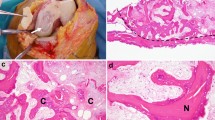Abstract
Purpose
The aim of this study was to obtain data on chondral damage and compare the damage patterns of various hip disorders.
Methods
Data were collected at 100 consecutive arthroscopies, and chondral lesions were recorded on anatomic articular maps divided into different anatomical zones. This geographic zone method made it possible to analyze the ICRS grade and location in relation to the hip morphology.
Results
The distribution and degree of the chondral defects showed a hip morphology-specific pattern. On the acetabular side, there were high incidences of full-thickness defects in the anterior–superior zone and the middle superior zone in patients with femoroacetabular impingement (FAI) (zone 2: 25.4 % grade 3, 35.5 % grade 4; zone 3: 20.3 % grade 3, 37.2 % grade 4) and borderline dysplasia (zone 2: 31.2 % grade 3, 12.5 % grade 4; zone 3: 18.7 % grade 3, 25 % grade 4). However, in patients with joint laxity, partial-thickness defects were dominant (zone 2: 50 % grade 1, 15 % grade 2; zone 3: 40 % grade 1). In patients with acetabular dysplasia, full-thickness defects extended even to the posterior superior zone (zone 4: 80 % grade 4). On the femoral head side, the incidence of full-thickness cartilage injuries was high in patients with FAI and borderline dysplasia compared to those with joint laxity and acetabular dysplasia.
Conclusion
Evaluation of chondral damage using the geographic zone method showed that the pattern of cartilage damage was influenced by hip morphology. Understanding of hip disorder-specific chondral damage patterns may be useful for the development of arthroscopic classification of hip disorders and may lead to the establishment of treatment guidelines.
Level of evidence
Diagnostic study, Level III.




Similar content being viewed by others
References
Beck M, Kalhor M, Leunig M, Ganz R (2003) Hip morphology influences the pattern of damage to the acetabular cartilage. J Bone Joint Surg Br 87-B:1012–1018
Bogunovic L, Hunt D, Prather H, Schoenecker PL, Chohisy JC (2014) Activity tolerance after periacetabular osteotomy. J Bone Joint Surg 42:1791–1795
Byrd JWT, Jones KS (2011) Arthroscopic management of femoroacetabular impingement in athletes. Am J Sport Med 39:7S–13S
Domb BG, Stake CE, Lindner D, El-Bitar Y, Jackson TJ (2013) Arthroscopic capsular plication and labral preservation in borderline hip dysplasia. Two-year clinical outcomes of a surgical approach to a challenging problem. Am J Sport Med 41:2591–2598
Fontana A, Bistolfi A, Corva M, Rosso F, Massazza G (2012) Arthroscopic treatment of hip chondral defects: autologous chondrocyte transplantation versus simple debridement—a pilot study. Arthroscopy 28:322–329
Ganz R, Parvizi J, Beck M, Leunig M, Notzli H, Siebenrock KA (2003) Femoroacetabular impingement. Clin Orthop Relat Res 417:112–120
Hjelle K, Solheim E, Strand S, Muri R, Brittberg M (2002) Articular cartilage defects in 1000 knee arthroscopies. Arthroscopy 18:730–734
Ilizaliturri VM Jr, Byrd JW, Sampson TG, Guanche CA, Philippon MJ, Kelly BT, Dienst M, Mardones R, Shonnard P, Larson CM (2008) A geographic zone method to describe intra-articular pathology in hip arthroscopy: cadaveric study and preliminary report. Arthroscopy 24:534–539
Javed A, O’Donnell JM (2011) Arthroscopic femoral osteochondroplasty for cam femoroacetabular impingement in patients over 60 years of age. J Bone Joint Surg 93B:326–331
Johnstone TL, Schenker ML, Briggs KK, Philippon MJ (2008) Relationship between offset angle alpha and hip chondral injury in femoroacetabular impingement. Arthroscopy 24:669–675
Karthikeyan S, Roberts S, Griffin D (2012) Microfracture for acetabular chondral defects in patients with femoroacetabular impingement: results at second-look arthroscopic surgery. Am J Sport Med 40:2725–2730
McCarthy JC, Lee JA (2004) Arthroscopic intervention in early hip disease. Clin Orthop Relat Res 429:157–162
McDonald JE, Herzog MM, Phillippon MJ (2014) Performance outcome in profesional hocky players following arthroscopic treatment of FAI and microfractures of the hip. Knee Surg Sports Traumatol Arthrosc 22:915–919
Notzli HP, Wyss TF, Stoecklin CH, Triber K, Hodler J (2002) The counter of the femoral head-neck junction as a predictor for the risk of anterior impingement. J Bone Joint Surg Br 84:556–560
Philippon MJ, Schenker ML, Briggs KK, Maxwell RB (2001) Can microfracture produce repair tissue in acetabular chondral defects? Arthroscopy 24:46–50
Philippon MJ, Maxwell RB, Johnstone TL, Schenker ML, Briggs KK (2007) Clinical presentation of femoroacetabular impingement. Knee Surg Sports Traumatol Arthrosc 15:1041–1047
Philippon MJ, Pennock Gaskill TR (2012) Arthroscopic reconstruction of the ligamentum teres. J Bone Joint Surg 94:1494–1498
Werner CML, Ramseier LE, Ruckstuhl T, Stromberg J, Copeland CE, Turen CH, Rufibach K, Bouaicha S (2012) Normal values of Wiberg’s lateral center-edge angle and Lequesne’s acetabular index-a coxometric update. Skeletal Radiol 41:1273–1278
Acknowledgments
We thank Prof. N. Nakamura for helpful advices and Mr. M.K. Barrymore for comments on the manuscript.
Author information
Authors and Affiliations
Corresponding author
Rights and permissions
About this article
Cite this article
Kaya, M., Suzuki, T., Emori, M. et al. Hip morphology influences the pattern of articular cartilage damage. Knee Surg Sports Traumatol Arthrosc 24, 2016–2023 (2016). https://doi.org/10.1007/s00167-014-3297-6
Received:
Accepted:
Published:
Issue Date:
DOI: https://doi.org/10.1007/s00167-014-3297-6




